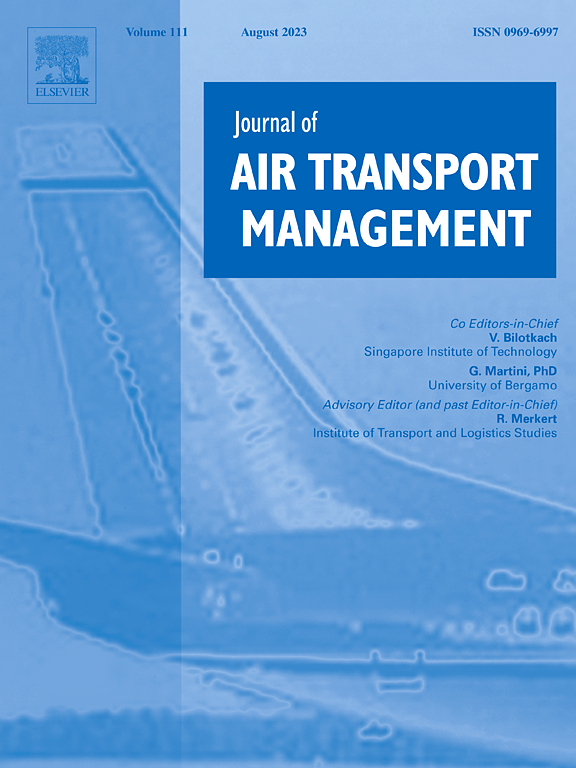美国机场客运量的决定因素:大都市经济在后大流行时代的作用
IF 3.6
2区 工程技术
Q2 TRANSPORTATION
引用次数: 0
摘要
鉴于2019冠状病毒病大流行对21世纪20年代初航空客运需求的破坏性影响,本文试图确定在大流行后时代,机场客运与大都市经济之间存在的一些传统联系是否发生了根本改变。此次分析只包括了美国联邦航空管理局(FAA)于2021年正式定义为空中交通枢纽的机场所在的首都圈。数据来自美国联邦航空局和美国人口普查局的美国社区调查。按大都会区划分的航空旅客空间分布在地理上高度集中,美国按大都会区划分的十大客运市场占所有客运的近一半。使用SPSS对航空旅客需求与一组预测变量之间的关系进行线性回归分析。在最后的回归模型中,大都市地区航空旅客需求变化的41.2%是由四个预测变量决定的:信息、运输和仓储、专业科学技术服务或PST、金融保险房地产或FIRE等行业的劳动力比例。这些结果似乎证实了早期的一些研究,即具有强大贸易服务部门的区域劳动力可以对航空运输提供产生积极影响。即使在2019冠状病毒病大流行的高峰期,那些在可贸易服务中所占比例不成比例的大都市地区往往也会产生更有弹性的航空客运市场,至少从它们从大流行的负面影响中“反弹”的方式来看是这样。本文章由计算机程序翻译,如有差异,请以英文原文为准。
Determinants of U.S. airport passenger traffic: The role of metropolitan economies in the post-pandemic era
Given the disruptive impact of the COVID-19 pandemic on air passenger demand in the early 2020s, this paper attempts to establish if some of the traditional links that have existed between airport passenger traffic and metropolitan economies have been fundamentally altered during the post-pandemic era. Only those metropolitan areas that included airports that the Federal Aviation Administration (FAA) officially defined as air traffic hubs in 2021 were included in this analysis. Data were collected from the FAA and the U.S. Census Bureau's American Community Survey. The spatial distribution of air passengers by metropolitan area was intensely geographically concentrated where the ten largest passenger markets by metropolitan area in the United States accounted for nearly half of all passenger enplanements. A linear regression analysis was performed to examine the relationship between air passenger demand and a group of predictor variables using SPSS. In the final regression model, 41.2% of the variation in air passenger demand by metropolitan area was accounted for by four predictor variables: the percent of the workforce employed in Information, Transportation and Warehousing, Professional-Scientific-Technical Services or PST, and Finance-Insurance-Real Estate or FIRE. These results appear to confirm some of the earlier research which articulated that a regional workforce with a strong tradable services sector can positively impact air transport provision. Even during the peak of the COVID-19 pandemic, those metropolitan areas with a disproportionate share of tradable services tended to generate more resilient air passenger markets, at least in terms of the way they “bounced back” from the negative impacts of the pandemic.
求助全文
通过发布文献求助,成功后即可免费获取论文全文。
去求助
来源期刊

Journal of Air Transport Management
TRANSPORTATION-
CiteScore
12.40
自引率
11.70%
发文量
97
期刊介绍:
The Journal of Air Transport Management (JATM) sets out to address, through high quality research articles and authoritative commentary, the major economic, management and policy issues facing the air transport industry today. It offers practitioners and academics an international and dynamic forum for analysis and discussion of these issues, linking research and practice and stimulating interaction between the two. The refereed papers in the journal cover all the major sectors of the industry (airlines, airports, air traffic management) as well as related areas such as tourism management and logistics. Papers are blind reviewed, normally by two referees, chosen for their specialist knowledge. The journal provides independent, original and rigorous analysis in the areas of: • Policy, regulation and law • Strategy • Operations • Marketing • Economics and finance • Sustainability
 求助内容:
求助内容: 应助结果提醒方式:
应助结果提醒方式:


